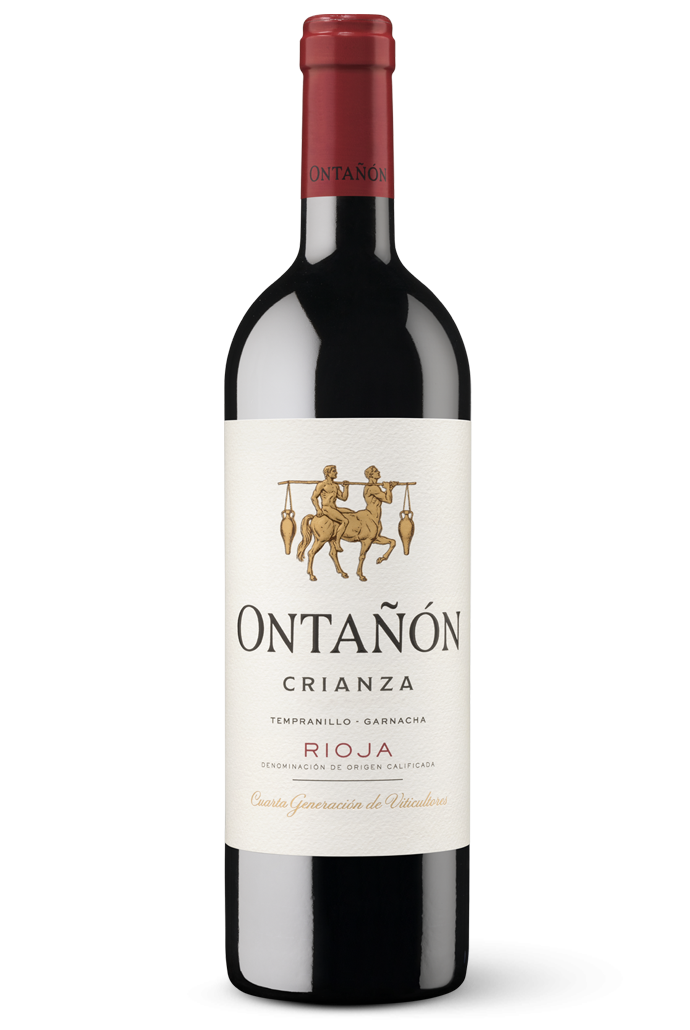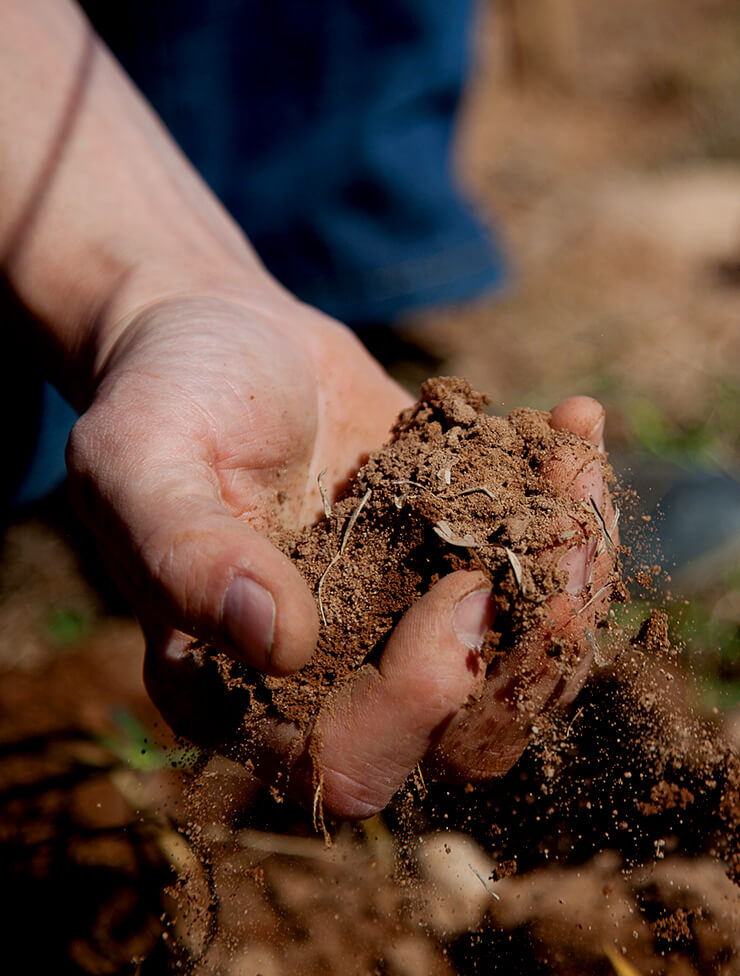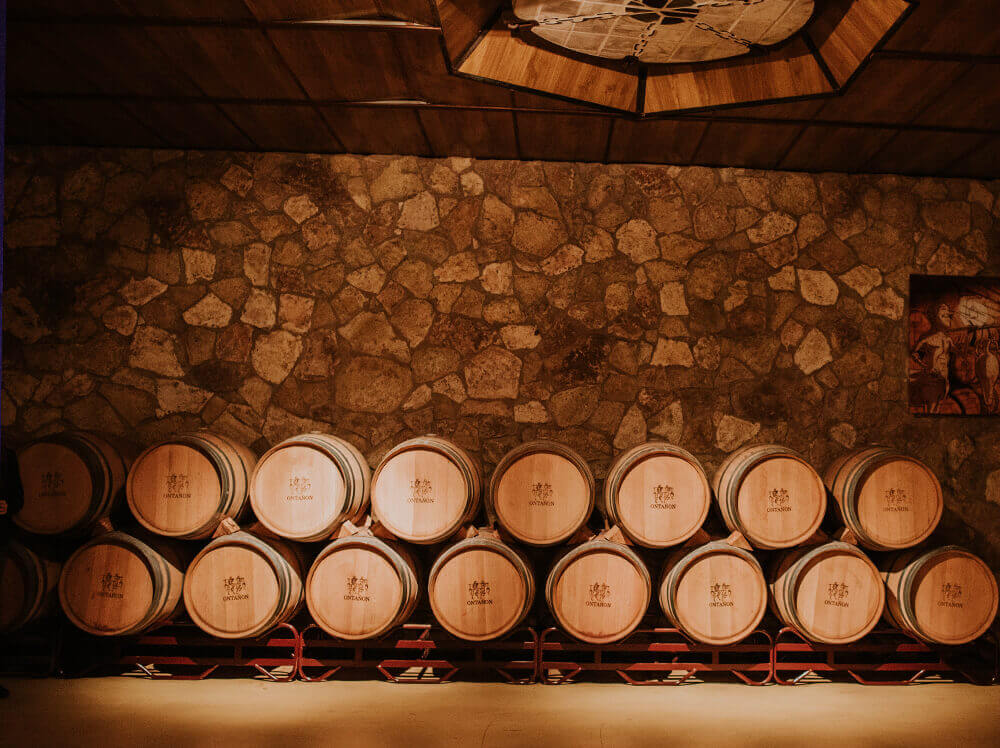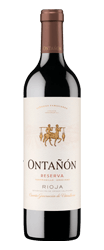Clásicos Collection
Fuimos, somos, seremos
Crianza
Essence of Rioja

A mixture of varieties and
terroirs
Ontañón Crianza is our essential wine
Essence means something that is important, characteristic or fundamental in a thing. And in Ontañón, our crianza combines these three conditions because each year it sets us a challenge in all these factors which come together when making a wine: maximum care in an increasingly rational and sustainable form of viticulture, winemaking practises firmly guided by the absolute pursuit of quality and the vocation of the people who devote themselves at each step in the path to achieve the infinite nuances of pleasure that an Ontañón Crianza can bring us when it reaches our palate.
Every harvest is different, because the climatological factors are also a fundamental part of this essence. It represents Rioja. Its soils, its climates, the altitude of each of our vineyards. The combination of two key varieties for our identity: tempranillo and the typicity of a tradition and such an important setting in the history of winemaking in Spain as Rioja, its landscapes, its people, its ways of making and living wine. A timeless tradition which we love and respect, and which is present in each and every one of the steps we take with this wine.
And the blend. The coupage. A mixture of varieties and terroirs. Knowing how to juggle a tiny universe of factors to ally yourself, with every vintage, every harvest, with excellence. In this case, one plus one never only makes two. The mixture of soils, so well planned, so well cared for, is much more than just adding them together. The result is to multiply the importance and the differentiating features.
- Two varieties: tempranillo and garnacha.
- A blend of selected, estate-owned vineyards.
- Two kinds of oak: American and French.
- An infinite number of factors to achieve excellence.
In cool years, Ontañón Crianza offers us different nuances to those in warmer years, in the mouth, on the nose, even in the feel. The fruit part moves us; it’s true, but we work with the casks so that the oak is present but does not dominate the aromas as a whole. A wine that expresses Rioja, its elegance, its length and the guarantee that it will always make you want to continue drinking. Rioja in essence. Essence of Rioja.

The biodiversity of the soils defines the vineyards of Ontañón
Family vineyards

Riojan Grenache from Ontañón Familia.
Ontañón Crianza springs from a surprising range of soil types, exposures and varieties. A territory packed with nuances in which the work of four generations has created a way of being, a style of making wines by remaining faithful to the land. We look after biodiversity because the richness of the surroundings is reflected in the wine’s aromatic imprint. We feel the biodiversity because it is our essence. Essence of Ontañón. Essence of Rioja.
Varietal Reality: tempranillo and garnacha. The reasons for a historic coupage
One of the keys to making Ontañón Crianza is its varietal diversity: tempranillo and garnacha as the basis of its continuity year after year. With the tempranillo we obtain length and give the wine durability, and with the garnacha, we give it an identity which is related to our essence of the Rioja Oriental, the identity of our roots, as well as the characteristics of the grape itself: body, sweetness and an unmistakable fruitiness.
As the winery oenologist Rubén Pérez Cuevas explains, tempranillo offers acidity, absolutely vital for ageing, as well as the characteristic silkiness and subtlety which are fundamental features of a variety which is fundamental in Rioja wines.
The percentage tends to be very similar almost every year: 80 per cent tempranillo and the rest garnacha. The reasons for these figures have been set by history, by knowledge and because “we must not vary the style of this wine much since it is essential to the identity of the bodega”. However, as Rubén explains, in recent harvests we have been gradually increasing the proportion of garnacha to improve the aromatic and organoleptic presence of the fruit: “The trend is marked by the role of the variety and we are doing it very gradually, in a controlled way so as not to los the identity of the wine, but stressing this vocation for fruitiness. The garnacha also brings us body and alcoholic strength, which is why so it is necessary for this evolution to be extremely subtle”.
Selection of the grapes
This is one of the key questions in achieving the quality we seek every year and which we regard as unswayable. A quality which is forked with each vintage and improves over the years. In Ontañón we have a historical record of the behaviour of each of our parcels of vines and we know perfectly the ripening potential of each vineyard which we use for making this wine.
The process is spread over the whole of the growing season. For example, we check the potential yield of the vines in the véraison stage so as to favour the most balanced ripening and for the vine not to be forced to make sterile efforts with grapes which will not be finally selected.
During the ripening period –which is a crucial moment in the evolution of the grapes and the setting of its fundamental characteristics with regard to aromas and colour- our team performs numerous checks of the ageing potential and we focus special attention of the phenolic maturity.
We make Ontañón Crianza exclusively from grapes which are sourced from vineyards at high, cool altitudes where acidity levels are maintained during the whole ripening process. Furthermore, we make a selection in the vineyard itself, since we have very exhaustive understanding of which are the micro parcels that ripen best.

Detailed work on the selection table.
How Ontañón Crianza is made
The winemaking process, always with each of the grape varieties vinified separately, takes place in stainless steel vats. In Ontañón Crianza we only use the free run wine, that is, wine made from the first must that flows before crushing.

Tasting in the winery’s production room.
The tanks are bled of five percent of the must so as to concentrate tannins and colour in a natural way, and the fermentation continues for seven days with a controlled temperature of 24 degrees. In this process we carry out pumping over, stirring and rack and return processes several times. Rack and return involves completely emptying the wine from the fermentation vat into another vat and, once the cap has descended to the bottom, the wine is returned to the original vat from above so that it falls onto the cap, thereby increasing the capacity for extracting the anthocyanins, tannins and phenolic compounds from the skins and pips.
Post-fermentative maceration
With post-fermentative maceration we favour the extraction of tannins which also help to give the wine more backbone. In addition, at this point we start to stabilise the colour through its combination with the tannins. There is also a release of manoproteins and polysaccharides, this time provided by the yeasts. This is all rounded off by the process of micro-oxygenation between the alcoholic fermentation and the start of malolactic fermentation which also favours the stabilisation of the colour and a reduction of the hardness of the tannins.
Cask ageing
Micro-oxygenation, fruit load and complexity
Our Ontañón Crianza is made using a blend of sources of oak for the casks: 75% American oak and 25% French. In this case, the casks are used for the first or second time. The new ones allow us to obtain faster ageing in less time, since their micro-oxygenation is greater. In addition, the release of compounds from the wood increases. However, there is less complexity.

Ontañón Familia barrels, always top quality.
That is why it is so important to use wood used for a previous wine, in which the ageing slows down and although the transfer of compounds is less, aromatically the wine results much more complex. This factor is also very beneficial for the preservation of the fruit in the wine. The work is very painstaking so as to achieve the perfect balance between the notes that come from the oak and the complexity and the fruit load that we obtain from the simultaneous use of new and used barrels we make during the year of cask ageing. A small puzzle which we put together with constant sampling and analysis.
The blend of casks made from French or American oak
With the combination of sources between French and American oak we are seeking complexity, finesse and balance in our wines. The American oak gives us more notes of vanilla, coconut, sweeter nuances…, while the French oak brings reminders of spices, like clove, peppercorn… In addition, as in the case of the number of uses of the barrels, the micro-oxygenation of the two types of wood are different, so we obtain wines with a higher fruit load and others with a greater presence of notes derived from the cask itself.
The American cask offers us higher rates of micro-oxygenation, so that the ageing process is faster. It also gives us more ageing notes in less time and aromas like coconut, vanilla, coffee, cocoa and tobacco appear.
The contribution of French oak is different, since it offers more tannicity, less evolution of the ageing over the same time and aromas of a more complex nature such as spices, pepper, cloves, toasted bread, cedar, dried fruit…
Toasting levels of the wood, key factors
In the Ontañón Crianza we work with medium and medium+ toast. Medium toast is less intrusive in the aroma and respects the fruit, bringing notes from the wood such as pepper, coconut and cedar. The medium + toast is more intrusive and the transfer from the wood produces aromas of caramel, honey, smoked nuances, cocoa, toast… By playing with the two toasting levels we manage to achieve the aromatic balance which we are looking for in our ageing.
We rack the casks twice per year. In this way we are able to homogenise the wines from different batches of casks, since although they come from the same supplier, oak and toast, each one has different nuances. We also correct the levels of sulphur dioxide and act on the wine’s cleanness, which, logically, precipitates during the ageing process. Another aim of racking is to make the wine more expressive, since we eliminate the matter that is in suspension and which consumes oxygen and lead to less expression in the wines.

Ontañón Barrel Ship, in the Temple of Wine.
The interview
Interview with Rubén Pérez Cuevas / Oenologist at Ontañón Familia.
How do you define the style of Ontañón Crianza?
Here we have a modern Rioja that has been able to adapt to the times since its first appearance with the 1996 vintage. We have always been in the forefront, looking to improve it each year as an obsession
It is a classic reference of blending, but there is also careful selection of vineyards. Do you think this also brings it identity?
Our starting point is that in the world of wine, eighty per cent is decided by the grapes, fifteen per cent is defined by the wood and the rest comes from the work of the people who make it, so the wine will always bear the imprint of the identity of the zone as the first description of its expression.
Has the style changed over the years?
The wine has always been faithful to its principles of a modern Rioja wine and continues to be so, although with subtle changes which position it among the benchmark crianzas in our region.
In what aspects can we appreciate this evolution?
Nowadays we tend to give more importance to the fruit and a little less to the wood; there is also body and volume. But it is a gentle revolution, almost imperceptible and which we are carrying out with the utmost care.

Rubén Pérez Cuevas, Oenologist at Ontañón Familia.
This five per cent which we mentioned earlier must make the coupages of this type of wines to be almost indistinguishable so that the person who enjoys them can continue to preserve the ever faithful memory of their style of wine. There is a vintage effect, but we work it with the maximum possible subtlety.
The current trend is more identity (origin of the vineyards) as opposed to typicity (Rioja style, for example). Where is the happy medium? To what extent do you consider this question when making the Ontañón crianza?
The identity comes from the grapes and the zone, the typicity from the climate and the region. We believe the balance lies in remaining faithful to the typicity without renouncing the identity of our territory. The Rioja of the thousand wines proves that, and whenever we make a blend we know we have to leave the identifying mark which accompanies along the way.
Another trend in the wine sector is the increasingly greater presence of wines with a fruitier character and less presence of the oak. Does Ontañón Crianza fit into this line of wines?
The current presence of fruit is very marked, but it has not always been exactly like that. Ontañón continues to adapt, with its subtle changes to this reality and we try to offer product capable of combining tradition and modernity, since it is necessary to move with the times to resist and evolve as the great wines we have in this and other regions of the world.
Some notes
Some notes on the history of Crianza in Rioja
Rioja are pioneers in controlling the ageing of wines.
Up until barely four years ago, with the approval of the Control Board of the DOCA Rioja of the new categories of Vino de Pueblo, Viñedo Singular and Viñedo de Zona, the length of ageing of the wines was the sole criterion for the official classification of Rioja wines into four different categories:
- Generic
- Crianza
- Reserva
- Gran Reserva

Back label models of the Rioja Regulatory Council.
As the journalist Javier Pascual recalls, while the issue of a specific model of back label by the Control Board for differentiating bottles that contain aged wines dates from April 1974, Rioja were pioneers in the control and certification of the ageing of the wines.
Historical milestones
Historical milestones in the ageing of Rioja wines
Key dates
1924. A group of producers asked for the recognition of a specific guarantee seal which would allow them to differentiate Rioja wines from the rest.
1925. Foundation of the Control Board of the Rioja Designation of Origin.
1928. First regulations of Rioja wines. Description of the Guarantee Seal: ‘A rectangle of 3 by 4 centimetre fine paper, with a space half a centimetre wide in the upper margin of the longest side of the face where the corresponding number can be written. In the lower margin there will be a similar space with the wording ‘Vino de Rioja’, and on the right, the word ‘Garantía’. In the centre of the seal, occupying the whole of the empty space, there will be an appropriate allegory for its purpose, which the Control Board will determine, with the seals for the moment being printed in a single coloured ink with an adhesive backing’.

1928. First Rioja guarantee seal and Council poster with the vintages..
1954. Agreement for the voluntary inclusion of these seals of guarantee of origin for wines bottled at source.
1970. The regulation of the Designation of Origin for the first time differentiates aged Crianza wines and stipulates a requirement of a minimum of a year in the oak cask.
1972. The assembly of the Control Board agrees to make the use of numbered back labels compulsory. It established January 1974 as the deadline for their application.
1974. In April of this year the Control Board started to issue a specific model of back label to differentiate the wines made with cask ageing.

First back labels of the Regulatory Council.
1976. The revised regulations of 1976 maintained the same definition and requirements for Crianza wines and added stricter rules for the categories of Reserva and Gran Reserva.
1979. Establishment of the norm for the four historic categories – vino de cosecha, Crianza, Reserva and Gran Reserva- and the issue of the corresponding labels by the Control Board.
1980. The year of the vintage was made a compulsory element on the back label. 1980 was the first vintage officially identified by the Control Board.

Various models of old seals from the Regulatory Council.
Awards and recognition
Worldwide for Ontañón Crianza
The influential American prescriptor James Suckling has just awarded 92 points to Ontañón Crianza 2020. And this is his assessment of the wine: “Baking spices, white sesame, red fruits and plums on the nose. Fine texture with a medium body, juicy red fruits and firm tannins. Quite long and elegant. Tempranillo and Garnacha. Very well balanced. Delicious now, but it can hold its own.
The prestigious British publication decanter awarded 92 points to our Ontañón Crianza in the Decanter World Wine Awards 2022. The Decanter tasters described the characteristics of our 2019 vintage thus: “It has aromas of strawberries and crisp blueberries. In the mouth it has floral notes and of lavender, with ripe, juicy fruit. The oak is smooth and tasty, with a long succulent finish”.
Ontañón Crianza is an emblematic wine in our bodega and has received an infinite number of prizes over the years: Gold Medal at the Brussels World Contest, Sommelier Choice Awards in the United States, or from the New York journal Wine Pair, which catalogued it as one of the twenty best wines in the world for less than 20 dollars.
Ontañón Crianza 2016 was rated as the best Spanish wine in the United States in the ‘Sommeliers Choice Awards’, a contest held in San Francisco in which the best sommeliers, wine buyers and wine managers from restaurants, bars, pubs and clubs from all over North America participated. Ontañón Crianza 2016, also obtained the Gold Medal in a tasting panel which is decided by a complex process of evaluation in which aspects such as the pairing possibilities, quality, typicity, value for money and presentation of the wines are considered.
The New York magazine VinePair selected the world’s best twenty wines for under 20 dollars (RRP in the United States) and Ontañón Crianza 2017 was the only one from the DOCa Rioja present in a list in which only two other Spanish wines appeared: Borsao Tres Picos (Campo de Borja) and Avancia Cuvée de O Godello (Valdeorras).
The influential British journal, Decanter, selected Ontañón Crianza 2015 in its January edition as one of the ten best Rioja crianzas in an article signed by the editor Julie Sheppard.

Raquel Pérez Cuevas, winemaker from Ontañón Familia.
Download
Tasting notes 2021
· PDF ·
Image Bottle
· JPG ·
Ontanon Crianza Catalog
· PDF ·
Previous vintages
Tasting notes 2020
· PDF ·



